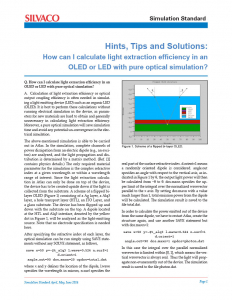Hints, Tips, and Solutions
Q. How can I calculate light extraction efficiency in an OLED or LED with pure optical simulation?
A. Calculation of light extraction efficiency or optical output coupling efficiency is often needed in simulating a light emitting device (LED) such as an organic LED (OLED). It is best to perform these calculations without running electrical simulation in the device, as parameters for new materials are hard to obtain and generally unnecessary in calculating light extraction efficiency. Moreover, a pure optical simulation will save simulation time and avoid any potential un-convergence in the electrical simulation.
The above-mentioned simulation is able to be carried out in Atlas. In the simulation, complete channels of power dissipation from an electric dipole (e.g., an exciton) are analyzed, and the light propagation and distribution is determined by a matrix method. (Ref. [1] contains physics details.) The only required material parameter for the simulation is the complex refractive index at a given wavelength or within a wavelength range of interest. Since the light extraction calculation in Atlas can only be done on top of the device, the device has to be created upside down if the light is collected from the substrate. A scheme of a flipped bi-layer OLED (Figure 1) consisting of a Ag layer, a Alq3 layer, a hole transport layer (HTL), an ITO Layer, and a glass substrate. The device has been flipped up and down with the substrate on the top. A dipole located at the HTL and Alq3 interface, denoted by the yellow dot in Figure 1, will be analyzed as the light-emitting source. Note that no electrode specification is needed here.



